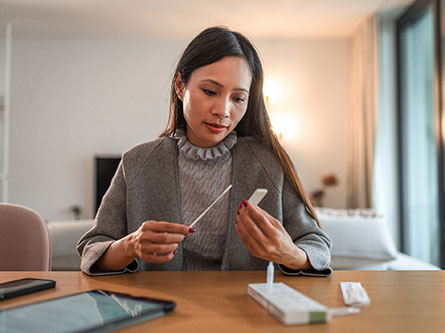
While the number of COVID-19 cases have gone down, at-home COVID-19 tests remain popular. But how do you know you're doing the test correctly to get the best results? UC Davis Health experts explain the at-home COVID tests and offer some advice on how to do your own test properly.
What is an at-home COVID rapid test?
These convenient tests are known as rapid antigen tests. They give results in 15-20 minutes, but it's important to do the test correctly to get the most accurate results. Although the at-home tests are less accurate than PCR tests during early stages of the virus, or when recovering from infection, they are convenient.
The at-home COIVD test involves a swab that is used to collect samples from both nostrils. It's then combined with a liquid buffer.
Explore other COVID testing methods
Instructions for at-home COVID tests
Always read the maker's instructions before using an at-home test. Here is a 10-step guide to do a rapid antigen test at home from iHealth. Most testing brands work in a similar way:
- Wash your hands well with warm water and soap for at least 30 seconds.
- The kit comes with two tests. Each contains three items: a collection swab, a test strip, and a small vial of liquid. Place them all on a clean surface.
- Open the collection swab and insert it into each nostril, rotating five times against the inner wall of the nose. You should insert the swab 1/2 to 3/4 of an inch into the nostrils. That's about the size of the tip of your pinkie finger. Put the swab back into its packaging because you'll need it again.
- Tap the bottom of the vial of liquid three times on a hard surface.
- Open the large vial cap and insert your swab into the vial. Stir the swab 15 times around.
- Squeeze the sides of the vial against the swab as you pull it out. This is important because it ensures that you get every bit of the collection. Then put the cap back on the vial.
- Open the test strip. You'll see that it has a "C" and a "T."
- Open the smaller, top cap on the vial of liquid, then squeeze three drops of your sample into the collection area of the strip.
- Set a timer for 15 minutes. Don't disturb the test strip during this time.
- Read your test.
Watch a video on how to use a rapid COVID-19 test at home
How do I read my at-home test results? What do the "C" and "T" mean on an at-home COVID test?
After 15 minutes, you'll look for two things:
- A line under the "C" lets you know that the test is working. If there's no line under the "C," you'll need to re-test.
- If the area under the "T," or test section, has no line at all, that means the test is negative for COVID-19. If there is a line under the "T," no matter how light or dark the line is, then you've tested positive for COVID-19.
Learn what to do if you test positive for COVID-19
How accurate are at-home tests?
At-home COVID tests aren't as sensitive as PCR tests that are usually done in a health care setting. However, a positive at-home test is pretty accurate if done correctly. There can be false negatives if it's early in the infection.
No test is completely accurate. These COVID rapid tests perform best when people with high viral loads test within a few days after COVID-19 symptoms appear. In people who have no symptoms, the sensitivity is improved by repeat testing over 36 to 48 hours.
Sign up for our Health Highlights e-newsletter
Where can I find an at-home test?
You can buy an over-the-counter rapid antigen self-test kit for $20 to $30 online or at drugstores. These at-home kits usually come with two tests, and you can use an app to track your results.
COVID-19 testing locations, which you can find through California's COVID-19 website, offer different types of COVID-19 tests, including antigen and PCR tests.




